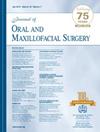两种不同的患者专用钻头/切割导轨用于微创双颌正颌手术时上颌复位的准确性。
IF 2.3
3区 医学
Q2 DENTISTRY, ORAL SURGERY & MEDICINE
引用次数: 0
摘要
背景:微创正颌手术(MIOS)需要更小的切口和最小的组织剥离。大多数MIOS是使用临时夹板来定位第一颌。由于传统的切割/钻孔导向需要更大的切口,因此在MIOS中应用患者特异性植入物是困难的。因此,本研究重新设计了MIOS指南,以适应更小的切口。目的:研究目的是评估和比较微创双颌正颌手术中使用的更小和重新设计的骨载与骨/牙载(BTB)切割/钻孔导轨的准确性。研究设计、环境、样本:这项回顾性队列研究包括2023年6月至2024年9月在德克萨斯大学圣安东尼奥分校由一名外科医生治疗的连续MIOS患者。它包括术前和术后有完整锥形束计算机断层记录的双颌MIOS患者。排除标准包括颅面综合征、严重的医学合并症或单颌手术。预测变量:主要预测变量是用于进行上颌截骨术的切割/钻孔导轨类型(BB vs BTB)。主要结局变量:主要结局变量为准确性,定义为最接近0 mm的平均线性差异。测量计划和实际上颌运动之间的线性差异。协变量:人口统计学和错牙合类型。分析:χ2检验比较分类变量,学生t检验评估准确性差异。P值< 0.05被认为是显著的,多次比较采用Bonferroni校正。结果:本组患者20例,其中女性15例,占75%;雄性5只,占25%;平均年龄24±11.3岁),平均分为BB组(n = 10)和BTB组(n = 10)。BTB导轨对上切牙(平均差值:0.67 mm,标准差= 0.33,P = 0.02)和左上犬齿(平均差值:0.11 mm,标准差= 0.04,P = 0.03)的垂直精度较好。然而,在均方根差异(P > .2)或其他测量值(P > .06)方面没有发现显著差异。结论和相关性:两种指南总体上都达到了可接受的精度,其中BTB指南在11个地标中的2个显示出更高的精度。本文章由计算机程序翻译,如有差异,请以英文原文为准。
Accuracy of Two Different Patient-Specific Drill/Cutting Guides for Maxillary Repositioning When Used for Minimally Invasive Bimaxillary Orthognathic Surgery
Background
Minimally invasive orthognathic surgery (MIOS) involves smaller incisions and minimal tissue dissection. Most MIOS is done using interim splints to position the first jaw. The application of patient-specific implants in MIOS is difficult due to the size of traditional cutting/drill guides, which require larger incisions. As a result, MIOS guides were redesigned for this study to fit into smaller incisions.
Purpose
The study purpose was to estimate and compare the accuracy of the smaller and redesigned bone-borne (BB) versus bone/tooth-borne (BTB) cutting/drilling guides used in minimally invasive bimaxillary orthognathic surgery.
Study Design, Setting, Sample
This retrospective cohort study included consecutive MIOS patients treated by a single surgeon at the University of Texas Health San Antonio from June 2023 to September 2024. It included patients that underwent bimaxillary MIOS with complete preoperative and postoperative cone-beam computed tomographic records. Exclusion criteria included craniofacial syndromes, severe medical comorbidities, or single-jaw surgery.
Predictor Variable
The primary predictor variable was the type of cutting/drilling guide (BB vs BTB) used to perform maxillary osteotomy.
Main Outcome Variable(s)
The primary outcome variable was accuracy, defined as mean linear discrepancy that is closest to 0 mm. Linear discrepancies between planned and actual maxillary movements were measured.
Covariates
Demographics and malocclusion type.
Analyses
χ2 tests compared categorical variables, and Student's t-tests assessed accuracy differences. A P value < .05 was considered significant, with a Bonferroni correction applied for multiple comparisons.
Results
The sample consisted of 20 patients (15 females, 75%; 5 males, 25%; mean age 24 ± 11.3 years) evenly divided into BB (n = 10) and BTB (n = 10) guide groups. The BTB guide demonstrated superior vertical accuracy for the upper incisor (mean difference: 0.67 mm, standard deviation = 0.33, P = .02) and the upper left canine (mean difference: 0.11 mm, standard deviation = 0.04, P = .03) when comparing means. However, no significant differences were found in root mean square discrepancies (P > .2) or other measurements (P > .06).
Conclusions and Relevance
Both guides achieved acceptable accuracy overall, with the BTB guide showing superior precision for 2 of the 11 landmarks.
求助全文
通过发布文献求助,成功后即可免费获取论文全文。
去求助
来源期刊

Journal of Oral and Maxillofacial Surgery
医学-牙科与口腔外科
CiteScore
4.00
自引率
5.30%
发文量
0
审稿时长
41 days
期刊介绍:
This monthly journal offers comprehensive coverage of new techniques, important developments and innovative ideas in oral and maxillofacial surgery. Practice-applicable articles help develop the methods used to handle dentoalveolar surgery, facial injuries and deformities, TMJ disorders, oral cancer, jaw reconstruction, anesthesia and analgesia. The journal also includes specifics on new instruments and diagnostic equipment and modern therapeutic drugs and devices. Journal of Oral and Maxillofacial Surgery is recommended for first or priority subscription by the Dental Section of the Medical Library Association.
 求助内容:
求助内容: 应助结果提醒方式:
应助结果提醒方式:


